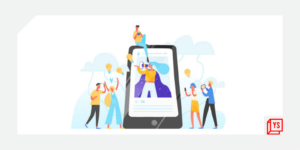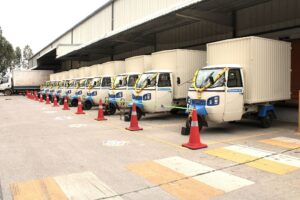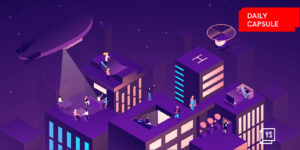
As technology evolves, newer horizons open up. As such, Generative AI has emerged as a game-changer, with applications like ChatGPT leading the charge. And as Generative AI gains widespread adoption and familiarity, our expectations of what technology multiplies along with it.
This is where a new era is ushered in— one in which AI assisting humans to accomplish tasks will become common rendering the once-popular trend of do-it-yourself obsolete.
Its impact is already becoming known, with Generative AI being present across industries from media, education, and customer service.
Making the switch to AI Apps
Just as we begin to welcome AI into various parts of our lives, we are also witnessing another wave of its use—AI apps. These AI-powered applications will not only be inherently smarter and more conversational, but they will also unlock higher levels of efficiency through advanced automation. They will use machine learning for deeper automation, employing natural language, image, and speech processing wherever applicable. The next phase of enterprise transformation will bring AI to every application, every business process, and every employee, surpassing what was previously deemed possible.
These apps will utilize Generative AI and Language Models (LLMs) to enhance intelligence and automation, making them more intuitive and capable of natural language understanding, logical reasoning, and contextual awareness.
AI apps will move beyond traditional graphical user interfaces (GUIs) and engage users through conversational interfaces, besides providing business intelligence by offering real-time decision support based on extensive knowledge bases. They will employ sophisticated algorithms to analyze large volumes of data, detect patterns, and make informed decisions.
Besides this, these apps will automate and orchestrate information and actions across the enterprise. They will deliver personalized experiences, continuously learn from human interactions and behavioral patterns, and optimize efficiency and accuracy in various domains.
Examples of improving employee Experience with Generative AI
Generative AI has the power to revolutionize the employee experience by improving various aspects of work, from HR to procurement to planning and operations.
Conversing with data
Visual dashboards are great at conveying information you need on a regular basis, in the format you need to consume it. But with the growing amount of information and the variety of sources, finding the right insights is often a challenge. Any meaningful what-if analysis or drill-down into data requires choosing the right datasets and widgets, applying the right filters and correlating with other data sources – often times a pretty time consuming and sometimes technically challenging even for the most savvy business users.
Being able to converse with your data in plain English can improve the user experience multifold, enabling the consumers of the data to analyze it from multiple different perspectives that the original dashboard designers may not have perceived. The ability to maintain context and continue further drill-down into the data through AI allows the user to extract insights in seconds, which would have otherwise required much more effort and time, oftentimes with having to involve other people.
Intelligent Employee Assistants
A vast majority of workplace applications revolve around mundane activities like filing timesheets, or leave applications, or updating CRM records or scheduling meetings. With no standardization across the systems of records and engagements in most enterprises, employees have to access several different portals or applications to get simple tasks done. Switching context, navigating through complex menus and dealing with software quirks often take more time than doing the actual data update itself.
An intelligent, personalized productivity tool, underpinned by a foundational LLM model, and a mapping of all the organization’s systems and people, can offload a lot of these mundane tasks to AI bots. Users can provide simple instructions like ‘file a personal leave for next Friday’, and the AI behind the scene would not only access the leave management system and file the leave, but also communicate back to the user if he or she has exceeded the leave allowances, if any additional permissions are needed, check the calendar for any critical meetings or deliverables for the day, re-assign tasks for the day to others as appropriate, and set up out of office messages in collaboration tools.
Employees on the other hand can move away from spending hours every week doing mundane tasks to getting things done with simple instructions to the intelligent assistants.
With full access to the organization’s knowledge bases, the assistants can guide the employees on navigating HR and finance policies, answer questions about benefits and reviews, analyze employee data, and identify skill gaps to provide customized learning experiences tailored to each employee’s needs.
AI-assisted Workflows
Enterprises are replete with workflow processes that span weeks and months, with involvement from multiple teams and dozens of people. With plenty of handover points, dependencies on each other’s actions and a variety of team sub-cultures and process tracking tools, running a time synchronized execution is often a big challenge. Onboarding a new employee or vendor, which could be done in days, often takes weeks, leaving a bad experience for everyone involved and measurable business impact. Navigating a complex approval hierarchy to get purchases done can become a nightmare. Getting team actions aligned and executed towards launching a new product or campaign on a given date can be an uphill climb.
Generative AI-driven workflow apps that have been trained on business rules and logic for a variety of different process scenarios can not only ensure workflows execute efficiently and effectively but can also help optimize the workflows as they learn from data and human actions. Imagine handing over a quotation for procuring laptops for your team to a procurement bot and asking it to do the needful. The bot can extract the items, prices, vendor and delivery terms from the quotation. It can figure out from past data if similar items have been procured at a lower price elsewhere, and if so, communicate back to the user or activate an exception process. It can check against the approved budget lines for the department for capex spend and trigger additional actions if the budget exceeds.
AI-based workflow tools can help businesses streamline their processes and systems by providing insights into operations’ functions and identifying improvement areas. Re-training an AI app to adapt to a newer process will be much faster and less error-prone compared to re-training or re-skilling human resources.
The future of work is here
Generative AI and AI apps are transforming the modern employee experience, revolutionizing the way work is conducted within organizations, in turn making them leaner, more efficient, and able to adapt to changes much faster. The shift from DIY to AI assistance represents a paradigm shift in how employees interact with technology. As AI becomes more pervasive, its impact will only deepen, and the lines between human and machine collaboration will continue to blur. The future of work is no longer a distant concept; it is here, and it is being shaped by Generative AI.
That being said, the rise of Generative AI will not render employees obsolete; instead, it will empower them to focus on higher-value work that requires creativity, critical thinking, and emotional intelligence. It will help foster a deeper sense of purpose for every employee in the organization.
Hardik Gandhi is the Founder-CEO of intelligent process automation company Zvolv.
Edited by Akanksha Sarma
(Disclaimer: The views and opinions expressed in this article are those of the author and do not necessarily reflect the views of YourStory.)








![Read more about the article [Startup Bharat] This B2B aggregator helps FMCG brands increase their rural footprint](https://blog.digitalsevaa.com/wp-content/uploads/2022/01/ImageBranding-Amisha5-1643295633874-300x150.png)
